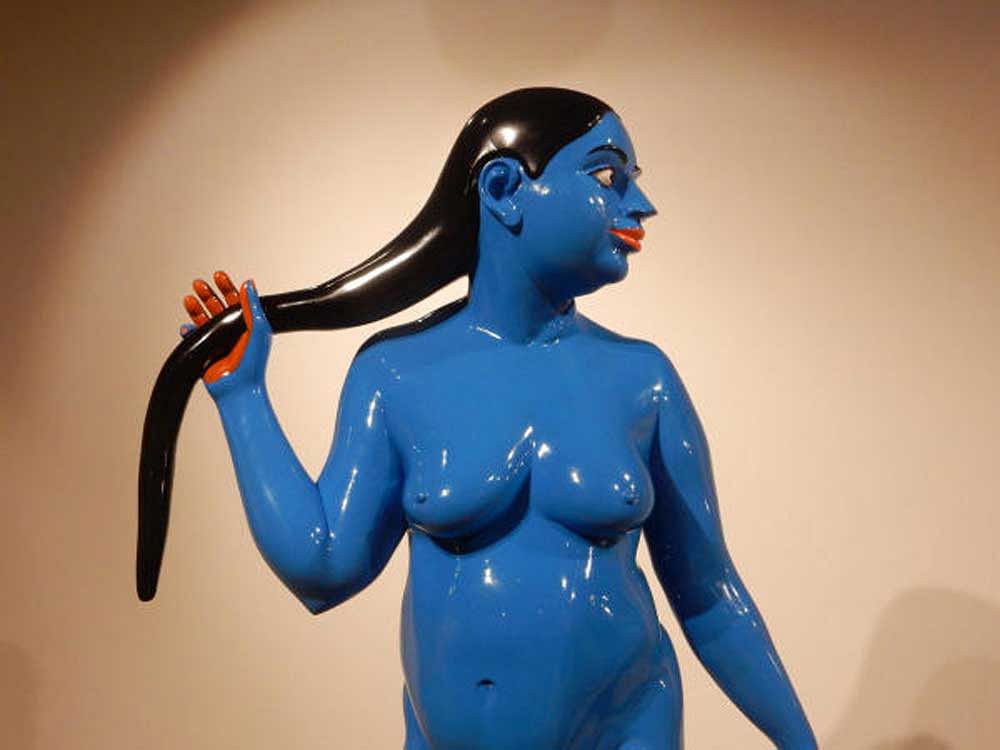In October 1996, a major exhibition ‘Contemporary Art in Asia: Traditions/Tensions’, was shown simultaneously at three venues in New York: The Asia Society, Grey Art Gallery and Queens Museum of Art. Curated by the leading Thai scholar and arts administrator Apinan Poshyananda, the event featured 70 works by 27 artists from South Korea, Indonesia, the Philippines, Thailand and India.
Among the six chosen artists from India was the then 40-year-old sculptor from Andhra Pradesh, Ravinder G Reddy (others being Bhupen Khakhar, Sheela Gowda, Nalini Malani, N N Rimzon and Arpita Singh). His three sculptures at the show were titled 'Head (of a Woman)', 'Sitting Woman', and '(Standing) Woman'.
Five years later, art critic of The New York Times, Holland Cotter, recalled how Reddy’s painted and gilded fibreglass sculptures of women were among the most visible examples of contemporary South Asian art since they first made a splash in ‘Traditions/Tensions' Exhibit in 1996. “His women, while commanding in scale and demeanour, have less-than-idealized features, closer to folk than to ‘fine’ art… A heroic art with a common touch: kitsch for the ages.”
Today, 61-year-old Reddy continues to draw critical and popular attention within the country and outside. His sculptures, particularly those celebrating the voluptuous and sensuous form of the Indian woman, have attained an iconic status.
Reddy is known to derive inspiration for his art from watching real people in everyday situations. He is also motivated by the figurative traditions of tribal and folk art from India as well as Egypt, Mexico, Greece and elsewhere. Using these influences to craft and develop his own brand of simplified figures, he often exaggerates them in scale and size and douses them in bright colours. A touch of theatricality and grandiose is reflected in his larger than life heads and strikingly seductive, unclothed bodies.
The Visakhapatnam-based artist was in Bengaluru recently in connection with his solo exhibition, ‘Heads and Bodies, Icons and Idols’ (The Gallery, RMZ Ecoworld /July 8-September 9, 2017). Here are some edited excerpts from the conversation:
On his recollection of ‘Traditions/Tensions’ Exhibition
I was working in Vizag when the curator wanted to meet me urgently in Bengaluru. Caught in two minds, I hesitatingly took a night bus to Bengaluru. Our discussion went off well; I saw that he was keen to have me on board. He seemed to like my work because it met his twin criteria: of being contemporary and ‘Indian’. Later, I found out that the show included artists like Bhupen Khakhar and Sheela Gowda, who were already big names. I thought my works would be in the shadow of theirs. But when the show began, the response to my work was very encouraging.
Someone showed me a copy of The New York Times with my sculpture prominently featured in it. I did not really make much of it, but only after others pointed out that artists would give their all to get even a small mention in NY Times, I was overwhelmed. Traditions/Tensions Exhibition, undoubtedly, made a big impact on my career because people in India and abroad started taking my work seriously thereafter.
On his art education
Even as a young boy, I knew that I wanted to become an artist. But my formal art education took off thanks to seniors like Devaraj Dakhoji and Laxma Goud, who encouraged me to go to Baroda and join the M S University. The Faculty of Fine Arts offered an openness to work in any medium or discipline; we could frankly discuss our projects with our teachers and peer group. Later, I went to Goldsmith College of Arts, London and Royal College of Art, London on scholarships.
On his choice of medium and subjects
I knew from the beginning I wasn’t good in drawing, particularly at creating perspectives. On the other hand, I was always fond of creating shapes, forms, volumes, which could happen in a three-dimensional medium like sculpture. Even now, I love playing and working with clay. Also, I feel sculptural works are accessible to everyone, from a child to a grown-up. Everyone likes to touch, feel and move around a three-dimensional object.
As for the subjects and themes, I think after absorbing many influences and inspirations, one makes his/her own choices and selections of what to pursue. Art cannot be literal or an exact reproduction of something we see. It becomes sterile and tedious then. One needs to infuse a sense of feeling, emotion and spirit to make it interesting. That is what I try to do when I sculpt. Why are my protagonists mostly women? Because I like the feminine form, gestures and postures. I feel a woman is definitely a strong life force.
On the scale of his sculptures
Colour and scale are very important to me as a sculptor. They, too, are matters of choice. I employ basic colours like red, blue, green and sometimes gold in my work. As for the scale, I was making small sculptures, heads in the beginning. My large-scale works
happened gradually.
Today, I’m comfortable working with any size.
On looking back at his work
When I see some of my earlier sculptures, I have mixed feelings. Could they have been conceived differently or shaped in a better way? After a while, I let such questions pass. In fact, once I finish a work, I develop a sense of detachment; that helps a lot in moving on. I must have made about a thousand sculptures in my career but haven't really kept a record of all of them.
On the art market
When we were young, we just wanted to be artists, often sustaining ourselves by taking up teaching and other part-time jobs. Things changed with time. Because of the art market, we could sell our works and make money. That helped us to experiment with mediums and also play with scale. The flip side was that one had to, at least to an extent, ‘oblige’ the market requirements, and that had its own impact on our work.
